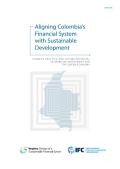This joint report by the Federation of Indian Chambers of Commerce and Industry (FICCI) and the UNEP Inquiry into the Design of a Sustainable Financial System highlights key proposals on aligning the Indian financial system with sustainability, by outlining feasible options for transformation of the Indian financial regulatory landscape, regulations and incentives that will channel finance into sustainable development priorities, and innovative markets for clean energy financing.

This document has been commissioned by the IFC and the UNEP Inquiry to explore the state of green finance in Colombia within the wider economic and financial sector context, and at the same time, to identify challenges and potential solutions that would enhance the application of environmental, social, and governance (ESG) criteria in the financial sector decision-making process and mobilize more investments for the transition toward a green economy.
The project involved two major steps:
1- it first undertook a holistic mapping of the Colombia green finance landscape with regard to the relevant stakeholders and the relevant types and volumes of finance, as well as current and planned financial policies, regulations, and standards;
2- it then identified the challenges that prevent increased green capital flow, and discussed how these might be overcome.
Central banks have wide ranging effects on the economy and society as a whole. Their decisions on monetary policy and sustainability are closely intertwined but the links between the mandates, objectives and instruments of central banks and a broad sustainability agenda are rarely reflected in policy debates.
This report focuses on monetary policy and its sustainability impacts in Bangladesh. It lays out areas for exploration and provides initial insights into Bangladesh’s economic development, its sustainability priorities as well as its financial system, and the relationship between these aspects and the country’s monetary policy. It also reviews the mandate, objectives, targets, and instruments of the country’s central bank, as well as the effectiveness of the transmission channels at its disposal. At the same time, it highlights that knowledge gaps on the topic remain significant.
This paper describes the challenge of modelling combined economic, ecological and financial systems and sets out a series of objectives for modelling the socio-economic transition towards sustainability. It highlights the modelling needs in relation to full employment, financial stability, and social equity under conditions of constrained resource consumption and ecological limits. It outlines the development of a dedicated system-dynamics model for describing Financial Assets and Liabilities in a Stock-Flow consistent Framework (FALSTAFF) and presents some hypothetical results calibrated for the Canadian economy. The selected scenarios illustrate the complex relationships between real and financial aspects of the macroeconomy and allow some initial tests on the financial viability of green investment.
Over 200 years ago, Adam Smith put forward the notion that individuals seeking to benefit themselves through trade were led as if by an invisible hand to a situation in which society as a whole could benefit. It can be argued, however, that social objectives such as sustainability and inclusiveness, do not emerge spontaneously through market forces. Such outcomes have to be designed through legal structures and institutions. In other words, for the invisible hand to operate, there needs to be a visible hand behind it.
By reviewing the financial inclusion experiments in South Africa and Kenya, this working paper provides some lessons for the design of the type of financial sector required for the transition from greed to green.
